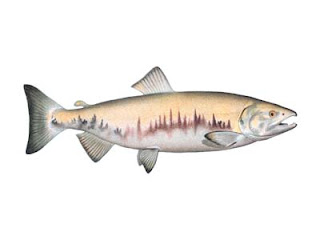 |
| Keta Salmon |
Keta (chum) salmon are considered to be almost extinct on the Oregon side of the lower Columbia River, according to Oregon Department of Fish and Wildlife (ODFW).
A cooperative effort of the Oregon and Washington departments of fish and wildlife seeks to restore populations of this unique salmon species to the river.
During early April 2011, ODFW released 106,000 juvenile chum salmon into lower Big Creek in the first phase of project attempting to re-establish the species.
Keta salmon began to disappear from the Oregon side of the river more than 50 years ago. Biologists believe that severe habitat degradation and other factors played a key role in their decline.
The approximately 50 adult Keta salmon male and female pairs used to produce the 2½ -inch fry at ODFW’s Big Creek Fish Hatchery were donated to Oregon by the Washington Department of Fish and Wildlife (WDFW). The adults were captured last fall in Grays River, a tributary of the lower Columbia on the Washington side of the river.
If adult Keta salmon make it back to Big Creek, they will be captured and spawned at Big Creek Fish Hatchery to produce more eggs and fry for release in subsequent years.
ODFW hopes to generate enough seed stock over time to begin out-planting Keta in other lower Columbia tributaries that are considered suitable for the species.
Keta salmon are generally more selective in their choice of spawning habitat than other species, according to Knutsen. These colorful salmon especially seek out upwelling areas associated with springs and seeps, he said, and they also prefer very clean, well-sorted gravel that is free of sands and silts that could smother their eggs.
If the program works as planned, Keta salmon will reproduce naturally in sufficient numbers that they will no longer need a boost from Big Creek Hatchery.
source: ODFW
During early April 2011, ODFW released 106,000 juvenile chum salmon into lower Big Creek in the first phase of project attempting to re-establish the species.
Keta salmon began to disappear from the Oregon side of the river more than 50 years ago. Biologists believe that severe habitat degradation and other factors played a key role in their decline.
The approximately 50 adult Keta salmon male and female pairs used to produce the 2½ -inch fry at ODFW’s Big Creek Fish Hatchery were donated to Oregon by the Washington Department of Fish and Wildlife (WDFW). The adults were captured last fall in Grays River, a tributary of the lower Columbia on the Washington side of the river.
If adult Keta salmon make it back to Big Creek, they will be captured and spawned at Big Creek Fish Hatchery to produce more eggs and fry for release in subsequent years.
ODFW hopes to generate enough seed stock over time to begin out-planting Keta in other lower Columbia tributaries that are considered suitable for the species.
Keta salmon are generally more selective in their choice of spawning habitat than other species, according to Knutsen. These colorful salmon especially seek out upwelling areas associated with springs and seeps, he said, and they also prefer very clean, well-sorted gravel that is free of sands and silts that could smother their eggs.
If the program works as planned, Keta salmon will reproduce naturally in sufficient numbers that they will no longer need a boost from Big Creek Hatchery.
source: ODFW
No comments:
Post a Comment